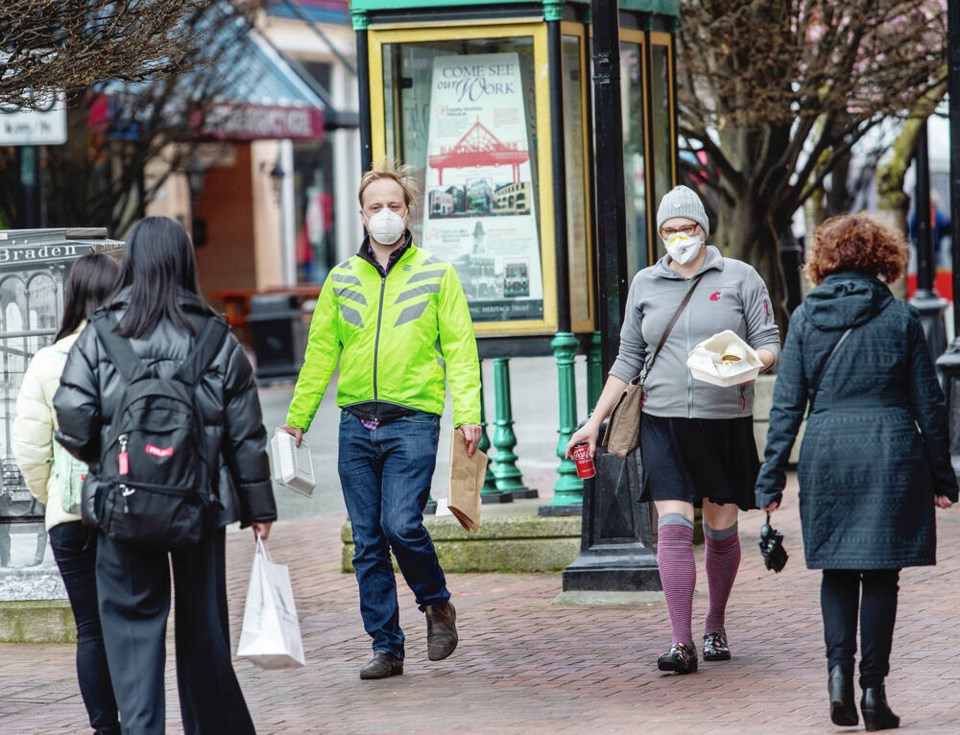As B.C. drops its vaccine passport, a member of the province’s COVID-19 Modelling Group is calling on businesses to encourage people to mask up.
Sally Otto, an infectious disease modeller on the team, which released its latest Wednesday, said the mask mandate is the one pandemic measure that needs to remain in place a little longer to protect access by vulnerable people to essential services such as grocery stores, drugstores and public transit.
“I would really highly encourage businesses to up their game and say: ‘Hey, we consider ourselves an essential service, so if you’re coming into this drugstore, if you’re coming into this grocery store, we want masks on everybody,’ ” said Otto, an evolutionary biologist at the University of B.C..
Effective today, the B.C. Vaccine Card is no longer required to enter non-essential businesses and events, though individual businesses can still require the card for entry. The move follows the elimination of a provincial mask mandate for indoor public spaces on March 12.
Otto supports the provision of a second booster, or fourth shot, for vulnerable populations, including those age 70 and older, Indigenous people 55 and older, and clinically extremely vulnerable individuals who are six months from their third COVID shot.
She said boosters should be offered in tandem with some sort of mask mandate. If cases and hospitalizations driven by the Omicron BA.2 variant increase, she expects calls for the mask mandate to grow over the next few weeks.
The COVID-19 modelling group’s latest report suggests the growth rate of the Omicron BA.2 variant is almost four per cent a day in B.C. and doubling every 15 to 20 days.
Otto noted that’s not as steep as the first Omicron wave, but said it’s hard to predict when the second Omicron wave is going to turn around. About 80 per cent of all new cases are driven by the Omicron BA.2 variant, said the group’s report.
The height of this wave will in large part depend on immunity, she said. Just over 91 per cent of adults are fully vaccinated, almost 60 per cent are boosted, and about 50 per cent of the population is assumed to have had COVID-19.
Otto said cases among the elderly, who are more consistently tested, are starting to rise. “BA.1 is declining steeply from the peak, but BA.2 has not been declining at all — it’s just been rising … and will continue to do so over the near future.”
Some jurisdictions, including South Africa, have seen a modest BA.2 wave, while others, such as the United Kingdom, are seeing similar levels of hospitalization as in the first Omicron wave, said the report.
Exponential growth of a small number of COVID cases and hospitalizations is not concerning, “but now we’re talking about larger numbers, and so doubling a large number is a problem, and doubling the number of people in hospital [would be] a problem,” said Otto.
There were 329 individuals in hospital in B.C. on Wednesday with COVID-19, including 37 in intensive care.
In Ontario, where the BA.2 variant wave started earlier, there’s been a surge of hospitalizations and cases — wastewater samples suggest the number of new daily cases is now matching peaks in January. The increase is thought to be related to a change in people’s behaviour, including going without masks.
Epidemiologist Dr. Peter Jüni, scientific director of the Ontario COVID-19 Science Advisory Table, has said people in Ontario should “mask up.”
Otto said a person who is vulnerable to serious illness from COVID due to their age or medical conditions and chooses to wear a mask only has limited protection if others in indoor close spaces who might be infected with COVID are not masked also.
Daily pandemic reporting switched to weekly reporting as of Thursday.



